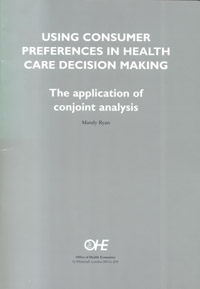Sign up to our newsletter Subscribe
Analysing Global Immunisation Expenditure

The idea that clients or users of public services might legitimately have opinions about how they should be delivered is a relatively new one in the United Kingdom, where producers’ views have dominated decisions about how things should be done. This tendency can…
The idea that clients or users of public services might legitimately have opinions about how they should be delivered is a relatively new one in the United Kingdom, where producers’ views have dominated decisions about how things should be done. This tendency can be observed not only in health care, but also in other public services such as education, the provision of social security benefits, policing, and the criminal justice system. Such neglect of users’ views is predictable where services are provided (often for excellent reasons) in a non-market context. Compare, for example, the careful way in which private hospitals question their patients on the quality of service they have received with the lack of interest (until recently) in such matters on the part of many National Health Service providers.
Clearly there are many aspects of health care, as well as of education and other public services, where the users lack the knowledge to determine the substance of the service they receive. Patients are not always well placed to determine the form of medical intervention which best meets their medical condition. But a variety of other attributes of health care, especially those which deal more with quality of delivery, are susceptible to judgements on the part of customers or users, who in this respect have a good claim to be the experts. Dr. Ryan’s paper provides a comprehensive and valuable review of one particularly promising method for eliciting consumers’ preferences and of its application to health care, where she has herself made a major contribution.
The method in question has been employed by market researchers for a number of years under the name of conjoint analysis. Using conjoint analysis, respondents are asked to make hypothetical judgements or to express preferences between hypothetical alternatives. From this it is possible to look at the relative importance of different aspects of the service. Within the public sector, many of the earliest applications can be found in the area of transport, where the technique is often described as a form of ‘stated preference’ analysis. Use of conjoint analysis can now also be found in the environmental literature. However, to date it has only had limited use in health care.
Conjoint analysis is subject to a number of objections, which are reviewed in more detail in the paper. One objection common to many possible areas of application is that respondents may give answers that do not reflect how they would actually behave if faced with the same decisions. A second objection is that if price is included as an attribute to be traded off, then supporters of free health care may be uncomfortable about the implications of the analysis. In other areas than health, these and other issues have been investigated, with generally favourable conclusions about the value of the information – provided that the studies are properly designed. These advantages led a research group at Brunei University, in a study funded by HM Treasury, to conclude that the stated preference approach had great potential for valuing quality changes throughout the public sector, and should be widely trialled (Cave et al, 1994).
The study noted that an attraction of conjoint analysis is that the metric which it employs to value the attributes of health or other services need not be a monetary one. Exercises require respondents to express preferences among alternative bundles of service characteristics, which may or may not include price. The procedure shows the rates at which users trade-off one attribute against another – for example, two separate attributes of quality or an attribute of quality and the quantity supplied. Avoiding the use of price as an attribute has the disadvantage that the results require more elaborate interpretation, but it has advantages as well. For example, many public sector managers operate within fixed cash limits, and since they cannot expand their budgets, willingness to pay data are of little direct interest to them. But information about trade-offs may be directly applicable in decision making.
Early indications suggest that conjoint analysis is a very promising approach to eliciting consumers’ preferences and I reiterate the Brunei study conclusion that it is ‘the one most likely to yield fruitful results in the valuation of quality of delivery in the public services’ (Cave et al, 1994). It appears to offer the best method yet available of answering the perennial question: how can we get user valuations of public services where, because of the nature of the services, we may not want users to pay for them? Dr. Ryan’s review shows that it is possible to apply conjoint analysis to problems in health care. In health care little is currently known about consumers’ preferences. If successfully applied conjoint analysis will provide a way of incorporating users’ views into NHS decision making.
Using Consumer Preferences in Health Care Decision Making: The Application of Conjoint Analysis
Ryan, M.
(1996) Using Consumer Preferences in Health Care Decision Making: The Application of Conjoint Analysis. OHE Monograph. Available from https://www.ohe.org/publications/using-consumer-preferences-health-care-decision-making-application-conjoint-analysis/
